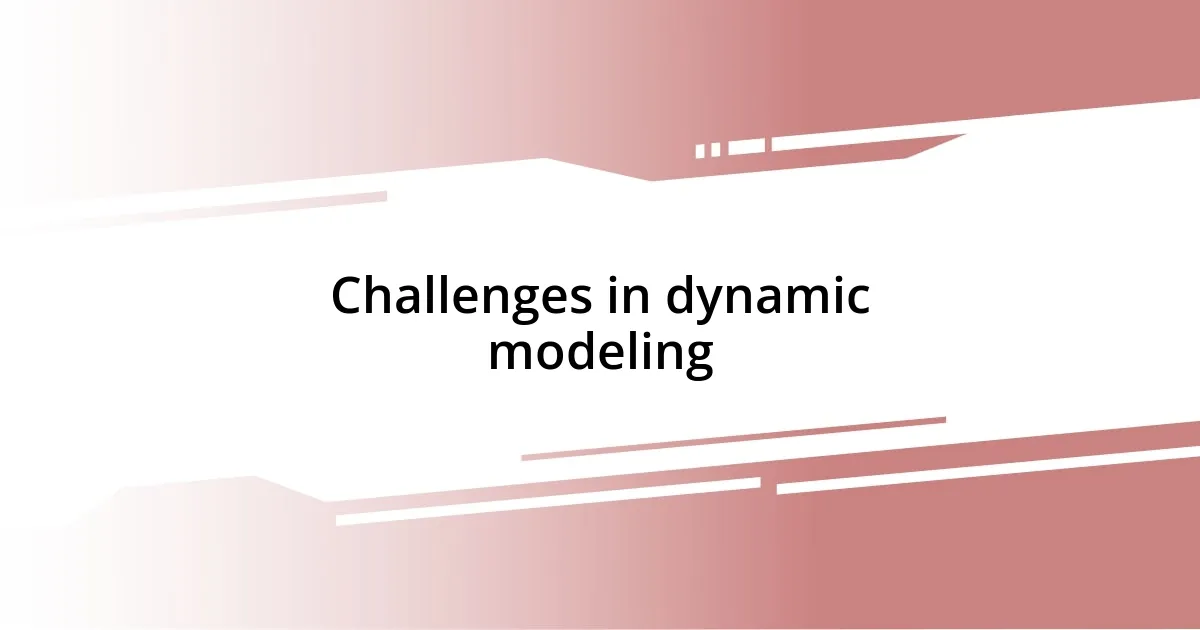Key takeaways:
- Dynamic modeling techniques, such as system dynamics and agent-based modeling, help visualize and predict complex system behaviors, informing better decision-making.
- Key principles include feedback loops, time dependence, and the need for interdisciplinary integration, enhancing understanding of real-world systems.
- Practical applications span numerous fields, including environmental management, public health, and business strategy, demonstrating the tangible benefits of these models.
- Challenges in dynamic modeling arise from the complexity of systems, data quality issues, and the integration of different modeling methods.

Overview of dynamic modeling techniques
Dynamic modeling techniques are fascinating tools that help us represent complex systems and their behaviors over time. From my experience, I’ve seen how these techniques can illuminate the intricate relationships within a system—whether in economics, environmental science, or engineering. The ability to visualize how changes in one part of a system can ripple through another is not just insightful; it’s essential for informed decision-making.
When I first encountered dynamic modeling, it felt like opening a door to a new understanding of reality. I often wondered how we could predict outcomes in anything as complex as climate change or market dynamics. By employing methods such as system dynamics, agent-based modeling, or discrete event simulation, we can capture these processes in a way that reveals patterns and potential scenarios. It’s like having a crystal ball that, while not infallible, offers glimpses into various futures based on our current actions.
One technique that particularly strikes me is agent-based modeling. It’s intriguing to think about creating virtual agents that mimic real-life individuals, each with their own rules and behaviors. This approach allows us to explore not just individual actions, but also emergent behaviors that may arise when these agents interact. Have you ever considered how the collective behavior of a community could change when each person is motivated by different incentives? That’s the beauty of dynamic modeling—it enables us to ask (and hopefully answer) such profound questions about our world.

Importance of dynamic modeling
Dynamic modeling is crucial because it provides a blueprint for understanding the complexities of real-world systems. In my own experience, I’ve observed that these models act like a map, guiding us through intricate relationships and feedback loops. This capability not only enhances our comprehension but also arms us with the tools necessary for proactive decision-making.
I remember a project where dynamic modeling transformed our approach to resource management. Instead of relying solely on static models, we employed system dynamics to visualize how water usage patterns would evolve over time. This shift not only illuminated potential shortages but also sparked conversations about sustainable practices among stakeholders who hadn’t previously been engaged. It’s uplifting to see how such modeling can inspire collective action towards a common goal, showing the true value of these techniques.
Moreover, dynamic modeling excels in predicting potential outcomes and testing scenarios without the risks associated with real-life experimentation. In one instance, I used agent-based models to simulate urban traffic systems. It was exhilarating to see how slight changes in traffic light patterns could lead to significant improvements in congestion. This kind of insight reaffirms why dynamic modeling is not just an academic exercise; it can lead to tangible, impactful changes in our daily lives.
| Feature | Importance of Dynamic Modeling |
|---|---|
| Understanding Complex Systems | Provides a detailed look at intricate relationships and feedback loops. |
| Scenario Testing | Allows for risk-free experimentation and understanding of potential outcomes. |
| Stakeholder Engagement | Encourages collaboration among diverse groups through shared insights. |
| Real-World Applications | Translates theoretical insights into practical solutions for societal issues. |

Key principles of dynamic modeling
Dynamic modeling is underpinned by several key principles that guide its effective application. One of the core concepts is feedback loops, which demonstrate how the output of a system can influence its input. I remember the excitement I felt when I first grasped this idea during a project involving ecological modeling. Observing how the population of a species could affect its resources—and vice versa—really highlighted the interconnectedness of systems. It was a lightbulb moment; I realized that understanding these loops could be a game-changer for ecological management.
Another important aspect is the concept of time. Models must account for the temporal dynamics that influence system behavior. For instance, in a recent analysis of market trends, I found that capturing delayed responses in consumer behavior was crucial. It was fascinating to see how certain changes didn’t manifest immediately but unfolded over time, highlighting the importance of patience in strategy development. Here are some key principles to keep in mind when approaching dynamic modeling:
- Feedback Loops: Show how system outputs can affect inputs, creating a cycle of influence.
- Time Dependence: Acknowledge the temporal aspects that influence behavior within a system, as outcomes may lag behind inputs.
- Adaptation: Consider how agents or systems change in response to their environment over time, allowing for a more realistic representation of dynamics.
- Scalability: Ensure that models can be adapted to different scales, from local to global impacts, reflecting the complexity of various systems.
- Interdisciplinary Integration: Leverage knowledge from multiple fields to enrich modeling techniques and enhance understanding.
Reflecting on these principles not only deepens my respect for dynamic modeling but also reinforces my belief in its immense potential to make sense of our complex world. It’s a journey of continuous learning and discovery, and I find it exhilarating.

Common dynamic modeling methods
Dynamic modeling encompasses various methods that help make sense of complex systems. One common technique is system dynamics, which uses stock-and-flow diagrams to visualize relationships over time. I once had the opportunity to apply this during a community health initiative. By modeling how health resources flowed into and out of our facilities, we could identify bottlenecks that were otherwise overlooked. Isn’t it fascinating how a simple diagram can bring clarity to something so multifaceted?
Another popular method is agent-based modeling, where individual entities (or agents) are simulated as they interact within their environment. I recall a project on wildlife conservation where we used this technique to model predator-prey interactions. Watching the agents behave according to defined rules grounded in real biology was eye-opening. This method not only revealed unexpected behaviors but also helped us predict population shifts under different scenarios. Do you ever wonder how small changes can lead to significant outcomes? This is exactly what agent-based models elucidate.
Last but not least, there’s discrete event simulation, which is great for systems that change at specific intervals. I found this particularly beneficial in a project focused on manufacturing processes. By simulating the sequence of operations, we identified redundancies that led to inefficiencies, allowing us to streamline operations. It’s rewarding to see how such models can illuminate paths to greater effectiveness. Have you considered how modeling different scenarios can prompt you to rethink traditional methods? The possibilities here are indeed endless.

Practical applications of dynamic modeling
Practical applications of dynamic modeling span various fields, and I often reflect on its role in environmental management. For instance, during a project evaluating urban expansion, we applied dynamic modeling to forecast how changes in land use would impact local ecosystems over time. It was striking to see how projected developments could ripple through the ecosystem, affecting everything from wildlife habitats to water quality. The revelation that our planning decisions could have long-term consequences was both a responsibility and an empowerment to drive more sustainable practices.
In the realm of public health, I experienced firsthand the power of dynamic modeling during a pandemic response initiative. By simulating the spread of a contagious disease, we could visualize the impact of intervention strategies like vaccination and social distancing. I remember the urgency of those discussions, knowing that our modeling outcomes could influence real-world policies. This kind of modeling isn’t just number-crunching; it’s a vital tool that shapes how we respond to crises. Can you imagine being able to predict the outcome of different health policies before they are implemented? That’s the immense potential we’re tapping into.
Another practical application that remains vivid in my memory is in business strategy development. At one point, I led a project that modeled customer purchasing behavior over several seasons. The insights we gained about how consumer preferences shifted over time were invaluable. I remember presenting our findings to stakeholders, and seeing the “aha” moments on their faces as we unraveled complex patterns. This is where the beauty of dynamic modeling shines—turning intricate data into actionable insights that can significantly enhance decision-making. Have you ever considered how modeling could inform your own strategies? It truly opens up a world of possibilities.

Challenges in dynamic modeling
Dynamic modeling can be quite challenging, primarily due to the complexity of the systems being modeled. I’ve found that accurately representing real-world phenomena often requires a deep understanding of numerous interacting components. For instance, in one of my projects on urban transportation systems, we faced difficulties in capturing the nuanced behaviors of commuters. How do you encapsulate the unpredictability of human behavior in a model? It’s a puzzle that requires both skill and intuition.
Another significant hurdle is the availability and quality of data. In one case, while developing a model for resource allocation in healthcare, we encountered gaps in essential data—data that was vital for making informed decisions. I remember the frustration of trying to fill in those gaps with estimates; it felt like building a house on a shaky foundation. Isn’t it startling how data limitations can undermine the validity of otherwise robust models?
Moreover, integrating different modeling techniques can pose its own set of challenges. When I attempted to combine system dynamics with agent-based modeling on a project related to environmental change, I realized how tricky it is to marry two distinct methodologies. The synchronization of models required meticulous attention and a lot of trial and error. Have you ever experienced the frustration of trying to blend different models? It made me appreciate the importance of clear communication and collaboration among team members to cohesively address these challenges.














